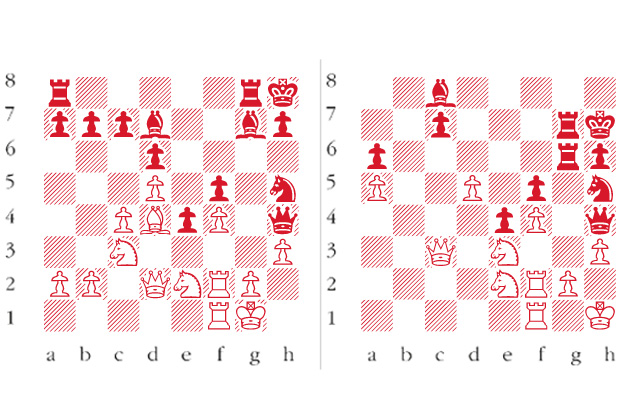As I write, young Jonathan Hawkins has stormed into the lead in the British Championship in Aberystwyth with the tremendous score of 6/6. This is not quite a record since in the British Championship of 1976, won by Jonathan Mestel, the new champion won his first nine games, a record unlikely to be surpassed.
It is too early to tell whether Hawkins has won this year but from what I have seen of his games his style exhibits a felicitous blend of accurate strategy and alert tactics, always a difficult combination of talents to confront. The following game is a case in point. Simon Williams is a grand-
master, notably gifted in the tactics department, yet Hawkins overruns him with a devastating sequence of sacrificial blows.
Williams-Hawkins; British Championship, Aberystwyth 2014; King’s Indian Defence
1 d4 Nf6 2 c4 g6 3 Nc3 Bg7 4 e4 d6 5 Bd3 Although this has been recognised as a main line, I find this early development of the king’s bishop somewhat suspect. It appears to me to lack the virtues of the Samisch Variation, 5 f3 and also those of the popular 5 Nge2 line. In particular, as indeed occurs in the game, White exposes this bishop to early attacks by the black knight. 5 … 0-0 6 Nge2 Nc6 7 0-0 Nd7 8 Be3 e5 9 d5 Nd4 Black cannot maintain this outpost since White can easily undermine it. However, after White’s next move, Black gains the advantage of the bishop pair. 10 Bc2 Nxc2 11 Qxc2 f5 12 exf5 gxf5 13 f4 Nf6 14 h3 Nh5 15 Rf3 New and incomprehensible. The simple 15 c5 as in Seirawan-Van Wely, Wijk aan Zee 1995, looks stronger. 15 … Bd7 16 Raf1 e4 Driving back White’s rook with gain of tempo. Black already has the superior position. 17 R3f2 Kh8 18 Qd2 Rg8 19 Bd4 Qh4 (diagram 1) Black’s forces gather ominously around the white king. 20 Nd1 Bxd4 21 Qxd4+ Rg7 22 Ne3 Rag8 23 Kh1 b6 24 b4 a6 25 a4 h6 26 c5 White ploughs on in the belief that his queenside breakthrough will be of significance while relying on the cluster of units around his king to defend him from disaster. 26 … bxc5 27 bxc5 dxc5 28 Qxc5 Bc8 29 Qd4 Kh7 30 Qe5 Rf7 31 Qc3 Rg6 32 a5 Rfg7 (diagram 2) Black has reorganised his heavy artillery in such a fashion as to break the pin along the a1-h8 diagonal, to defend his queenside pawns in lateral fashion and yet to maintain his massed batteries pointing in the direction of the white king. 33 Qe5 Ng3+ 34 Nxg3 Rxg3 35 Re2 Re7 36 Qd4 Bd7 37 Rc1 Setting himself up for a gargantuan pitfall. It is better to liquidate with 37 d6 cxd6 38 Qxd6 when 38 … Rg6 39 Qd4 leaves White well in the game. 37 … Qxf4 38 d6 cxd6 There is nothing wrong with 38 … Qxd6, but the text contains a diabolical petard. 39 Rc7 Reg7 40 Qa7 Qe5 41 Rxd7 A blunder but his position is already hopeless. 41 … Qa1+ White resigns 42 Kh2 Rxh3+ mates.
The biennial chess Olympiad is imminent in Tromso, Norway. The puzzle this week constitutes one of the most brilliant finishes ever to have been seen in a chess Olympiad.
Raymond Keene
Treasure Island

issue 02 August 2014




Comments